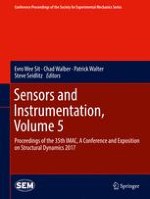2017 | Book
Sensors and Instrumentation, Volume 5
Proceedings of the 35th IMAC, A Conference and Exposition on Structural Dynamics 2017
Editors: Evro Wee Sit, Chad Walber, Patrick Walter, Steve Seidlitz
Publisher: Springer International Publishing
Book Series : Conference Proceedings of the Society for Experimental Mechanics Series
